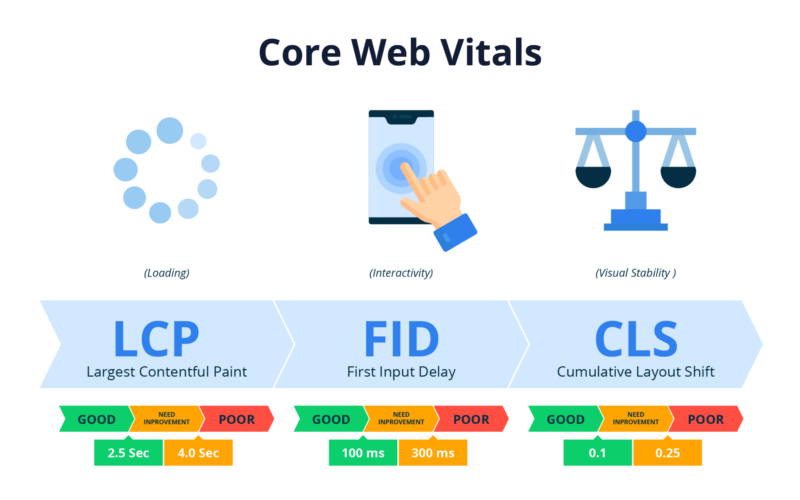Speeding up WordPress Themes: Improving Core Web Vitals
WordPress theme performance has become crucial for website owners as Google’s Core Web Vitals continue to affect search rankings and user experience. The metrics that make up Core Web Vitals, such as Largest Contentful Paint (LCP), First Input Delay (FID), and Cumulative Layout Shift (CLS), have a direct bearing on how people perceive and interact with a website. Identifying Core Web Vitals measurements, delving into causes of subpar LCP, addressing FID problems, and examining how RabbitLoader can significantly improve website performance are all covered in this blog.
Identifying Core Web Vitals Metrics: LCP, FID, CLS
1. Largest Contentful Paint (LCP):
LCP calculates how long it takes for a page’s biggest element to become visible to visitors. Longer loading times and less user engagement are also possible effects of a low LCP score.
- Image optimisation: To minimise the size of photographs without sacrificing quality, use the right formats and compression.
- Content Delivery Networks (CDNs): Utilise content delivery networks (CDNs) to offer material from servers that are closer to the user, cutting down on latency and raising LCP ratings.
2. First Input Delay (FID):
First Input Delay (FID) is a measurement of how long it takes a website to become interactive when a user clicks a button or link. A user experience that is slow and unresponsive may be caused by a high FID score.
- Asynchronous Loading: To avoid stopping the main thread and enhance FID, use asynchronous loading for JavaScript files.
- Code splitting: Reduce FID by breaking up big JavaScript bundles into smaller pieces and loading just the scripts that are required on particular sites.
3. Cumulative Layout Shift (CLS):
CLS measures unexpected layout alterations to gauge a page’s visual stability. Users may become frustrated if a website receives a low CLS score due to moving components.
- Media Loading: To avoid layout changes while content loads, provide media components (such as photos, videos, and iframes) with defined dimensions.
- Use font-display: swap while loading fonts to prevent abrupt font changes that can compromise the stability of your layout.
Factors Leading to Poor Largest Contentful Paint (LCP)
Large images and media files: Media files that aren’t optimised can seriously harm LCP. Images may be made smaller and load more quickly by compressing them and using contemporary formats like WebP.
Render-Blocking JavaScript and CSS: JavaScript and CSS resources that are heavy and render-blocking might slow down LCP by delaying the rendering of the greatest content. Non-essential scripts can be delayed and/or minimised to assist solve this problem.
Slow Server Response Times: Slow server response times can delay the delivery of material and have an effect on LCP. Response times may be enhanced by utilising server-side caching and picking a reputable hosting company.
Heavy other-Party Dependencies: Plugins and scripts from other parties might drag down the page and impact LCP. Analyse each third-party dependency’s requirement carefully, and take into account lightweight alternatives.
Addressing First Input Delay (FID) Issues
JavaScript execution optimisation: Keeping lengthy processes to a minimum and speeding up JavaScript execution can boost FID dramatically. Interactivity can also be improved by delaying non-critical JavaScript and doing asynchronous loading.
Script optimisation for third parties: Social networking plugins and analytics scripts from third parties might exacerbate FID problems. Prioritise lightweight and well-optimized third-party scripts to reduce their negative effects on FID.
Resource Compression and Gzip: Gzip and resource compression can significantly decrease the file size of resources like JavaScript, CSS, and HTML. Smaller resource sizes result in speedier downloads and execution, which raises FID ratings.
Service Workers and Cache: Implementing service workers and cache techniques can store assets locally on the user’s device, enabling speedier retrieval and less reliance on the network. This strategy improves FID by cutting down on network fetch times.
Reducing Render-Blocking CSS: Recognise and improve render-blocking CSS that slows down a browser’s ability to swiftly render a page. For critical stylesheets, use the “preload” and “prefetch” attributes to ensure quicker page rendering and enhanced FID.
How RabbitLoader can help
RabbitLoader, an all-in-one performance optimization plugin, plays a crucial role in speeding up WordPress themes and improving Core Web Vitals.
Image Optimization: RabbitLoader’s advanced algorithms compress and optimize images, reducing their size without compromising quality. This results in faster loading times and improved LCP scores.
Script Management: RabbitLoader intelligently manages script loading, including jQuery deferral, to reduce render blocking and improve FID scores. Asynchronous script loading enhances page interactivity and user experience.
Lazy Loading of Images: RabbitLoader supports lazy loading of images, loading them only when they come into the user’s viewport. This reduces initial page load times and contributes to a better CLS score.
Remember, a fast and seamless user experience not only delights visitors but also positively impacts conversion rates and user retention. By staying proactive in optimizing Core Web Vitals, website owners can stay ahead of the curve in the ever-changing digital landscape and deliver outstanding online experiences for their audience. Embrace the power of optimization, and watch your WordPress site thrive in the era of Core Web Vitals and user-centric web design.
Prioritizing the optimization of WordPress themes for improved Core Web Vitals is paramount for enhancing both user experience and search engine rankings. By proactively addressing factors affecting Largest Contentful Paint (LCP) and mitigating First Input Delay (FID) issues, website owners can create a more responsive and engaging platform.
